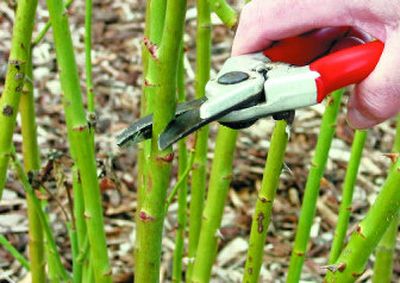When panic attacks, I attack roses

A trip out to the garden sent me into despair. It does every year at this time. Even though April is upon us and there are signs of life everywhere in the garden, no one can convince me that the glory of last season will repeat itself. The garden is a ravaged mess from winter and the merciless deer. I panic at the work ahead of me. But fortunately, I also have the antidote. It lies in the roses. It is time to prune them. Once the pruning starts, the panic subsides.
To most people it may seem late to wait until April to prune roses. But since we live up on a hill, things are usually two weeks behind what is going on in town. I am wary of the capricious nature of March, when very often nighttime temperature can dip to 20. If I prune then, I worry the frost will do further damage to the already severe winter kills. So I wait until early April and work furiously to catch up. The challenge of this is the damage I inevitably cause to some tender buds. When that happens, which is often, I feel as if my own flesh is peeling off.
In the beginning, when there were just a few bushes to contend with, I faithfully did a by-the- book fall pruning. There were a couple of years that I even covered the roses with straw. Despite the effort, the bushes died down to the ground every winter.
In the spring, when I cut all those dead twigs off, the garden would be completely flat, devoid of any vertical focus. It is always amazing to me that most of them come back.
Two years ago, after an overworked summer and with over 100 roses, I started wondering if fall pruning was really necessary.
Do people prune so that the garden looks well kept and tidy and the gardener feels better? Or do we prune so that the plant feels better and is ensured a better future? I can see the first but am not sure about the second. I decided to experiment and skipped the fall pruning altogether.
Even though the sight of a garden full of ugly dead twigs did not faze me, when the icicles began to form on them, I worried. Was there too much exposure for the plant? Would this exposure kill the root? When the wind blew and the skinny twigs swayed, I cringed and doubted my ingeniousness. But mostly, I blamed my laziness, something very easy to do in December when one is rested up from all garden chores.
By spring, it was apparent that the experiment had made not much difference. Most of the bushes still died back all the way to the ground. I did lose a few climbers. There were three Golden Showers. Only two survived.
Both Royal Gold climbers died as well. I don’t know if they were victims of the experiment or other careless improper care inflicted upon them. Climber Royal Gold is a tea rose and is probably more suitable for a warmer zone.
Last fall, I decided not to prune again. In fact I probably will not do fall pruning again, given the difference it makes. This winter was a mild one compared to the years past. All the roses seem to have survived, or at least not blackened to the ground as in years past.
Maybe, for once in April, I will have some vertical reminder of a garden coming to full bloom in summer.